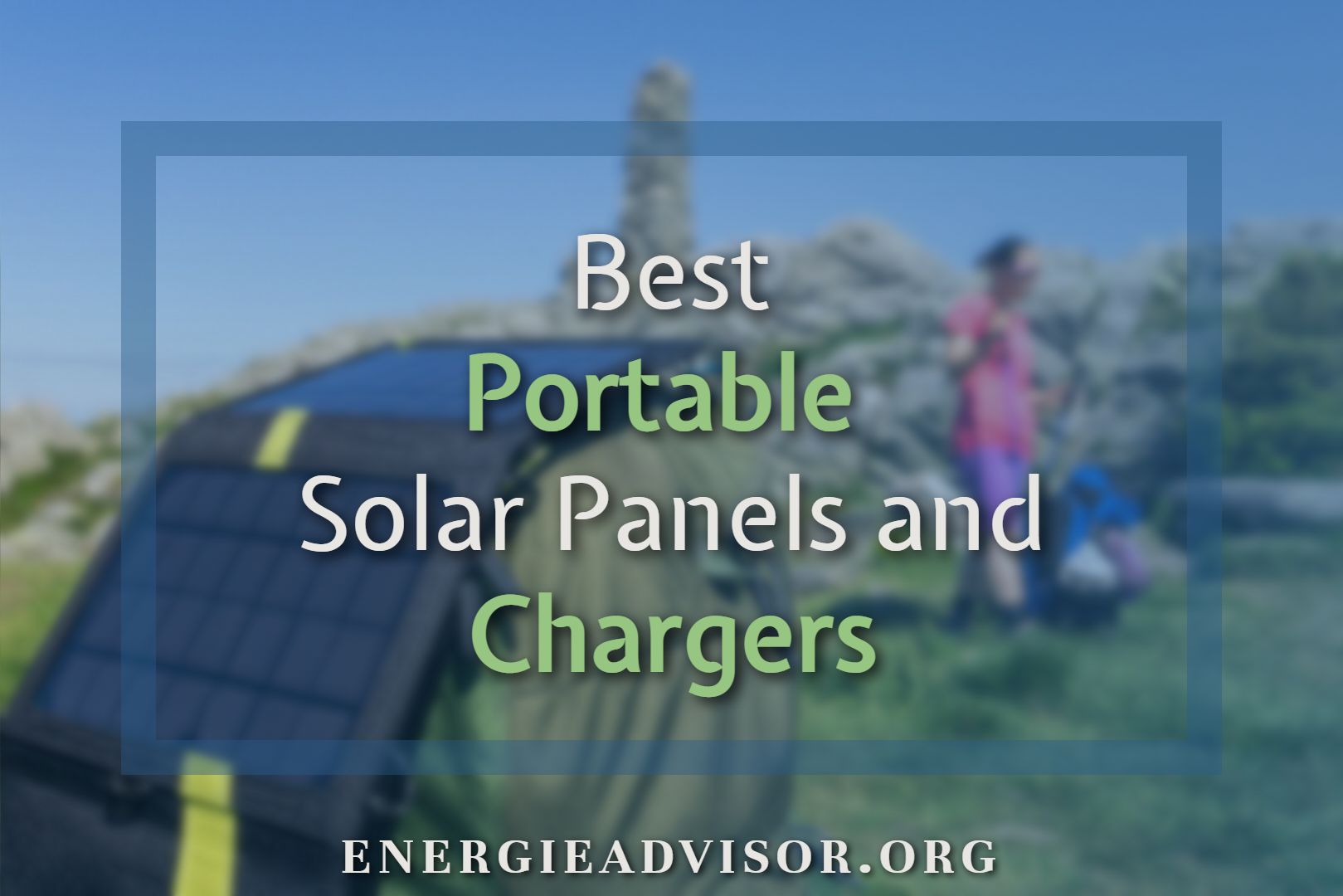When you’re out in the country, and your smartphone or laptop battery dies, you’re bound to end up frustrated. Whether we like it or not, we are sometimes dependent on these powerful and intelligent devices. We need the energy to power them, but how do we do that when there are no energy sources around?
The key is in portable solar panels and chargers. Harnessing the power of the sun, these gadgets are real lifesavers, giving us freedom from wall outlets. They’re invaluable to anyone on the go and are among the most convenient devices you can carry with you on your outdoor adventures.
Comparison Table:
With so many different brands and models, however, selecting a single portable panel or a charger can be daunting. To help you out, we’ve rounded up and analyzed some of the market’s most exciting offerings of best portable solar panels. We’ve also written a couple of handy guides to make your shopping a bit easier.
Top Picks Portable Solar Panels
1. Ravpower 24w Solar Charger – Editor’s Pick
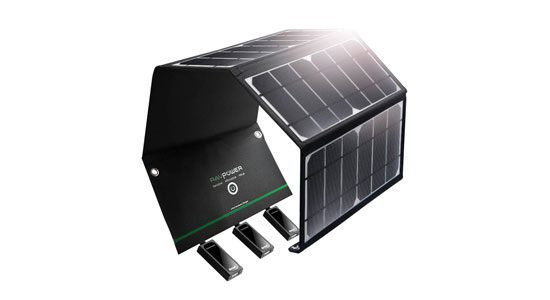
Highlights:
- Rugged, durable design
- Highly efficient
- Three USB charging ports
- Can be folded for easier storage
- Can be used stationary and on-the-go
Relying on the power of the sun, it’s no wonder that solar chargers aren’t among the market’s most popular electronic devices. However, some of these gadgets undoubtedly deserve a closer look, and one of those is the RAVPower 24W Solar Charger.
As you can already guess, this lightweight model is an ideal solution for backpackers. As it can be folded up, easy storage is guaranteed. Moreover, the overall design and the materials protect the RAVPower 24W from external damage. Most importantly, however, the model provides excellent results in terms of charging.
The 24W cells used in this charger offer the best performance on the market. They can deliver up to 2.4A of energy to one’s electronic devices. This is the result of their capability of converting close to 24% of sunshine into usable energy.
This solar charger also takes into account the fact that most people want to charge more than one gadget at once. The company has equipped the device with three USB charging ports. The model works best when it’s stationary, and its panels are facing direct sunlight. Charging on the go is also possible – you can fix the RAVPower 24W on your backpack.
The rugged construction of this product is particularly impressive. Combining tidy stitching, riveted eyelets, strong Velcro, and thick waterproof canvas, it’s an extremely durable solar charger.
A premium product in function and design, RAVPower 24W Solar Charger deserves the status of our Editor’s Pick. It’s one of the best devices of its type on the market and a worthwhile investment.
2. Nekteck 21W Solar Charger – Best Budget Friendly
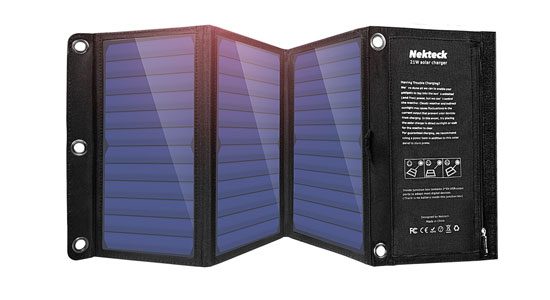
Highlights:
- Highly affordable
- Compact, lightweight & foldable
- Energy conversion rates of up to 24%
- Waterproof & rugged
- 18-month warranty
If you need a quality solar charger but also want to save some money, this may be the perfect product for you. Nekteck 21W Solar Charger is a budget-friendly model with advantages such as foldability, portability, and high efficiency.
Having the maximum conversion rate of 24%, this device can be a lifesaver even on not-so-sunny days. However, the presence of a zipped pouch means that you can also use it in high heat. The zipped pouch will protect your smartphones, cameras, and other devices from high temperatures.
One of the most exciting features of this model is the integrated smart chip technology. Neckteck calls it “smartIC”, and its job is to charge all the devices in a fast and safe manner. You’ll be able to keep using your devices as they’re getting charged. Using long charging cables, however, can have a negative effect on the charging speed.
Design-wise, this is an ultra-lightweight and highly portable model, at only 18 ounces. The solar panels themselves are of unexpectedly high quality, especially once we consider the unit’s price. The panels are sewn into a durable waterproof canvas material. For easy hanging, Neckteck has equipped the canvas with five steel holes.
As it can charge one’s gadgets at speeds that are close behind those provided by wall sockets, this model is every backpacker’s dream. It’s the extremely affordable price, however, that turns it into a genuinely fantastic deal.
3. Bigblue 28w – Best Waterproof
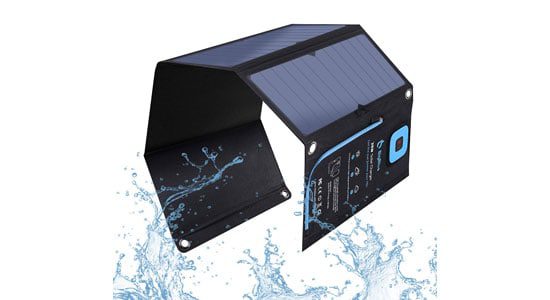
Highlights:
- Attractive design
- Reasonable price
- Waterproof
- Four efficient solar panels
- Built-in ammeter
If you often experience rain and moist conditions on your outdoor adventures, you need a waterproof solar panel. As it turns out, BigBlue 28W is one of the best waterproof models on the market.
Coming from a relatively unknown company, this solar panel/charger is both efficient and inexpensive. Although somewhat bulky, its size doesn’t matter that much in the long run – it simply gets the job done.
Design-wise, it’s one of the most attractive devices of this type on the market. It is, however, also quite durable. The canvas material that protects its outsides is highly resistant to wear and abrasions. There’s also a special zipper pouch, whose purpose is to hold your device (such as a smartphone) while it’s charging.
Using four efficient solar panels, the performance of BigBlue 28W is thoroughly impressive. The model is capable of outputting four amps and 28 watts in the best conditions. As you can already guess, this is enough to charge almost any gadget with a USB port.
Another exciting feature is the presence of an ammeter. Its purpose is to help the user find the best position for peak functionality. It displays the ampere output once the user connects his device to one of the USB ports.
The biggest advantage of this portable solar charger, however, is its resistance to water. BigBlue’s USB ports are covered with rubber grommets. For people who often hike in moist environments, it’s one of the market’s best options.
4. HQST 100 Watt – Easy to Use
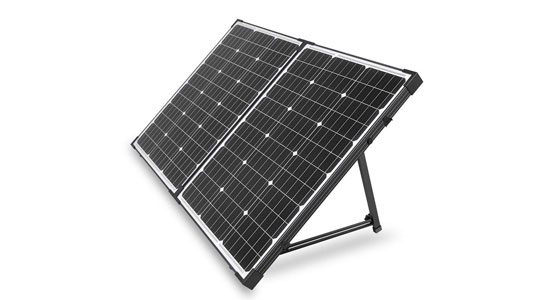
Highlights:
- Highly efficient monocrystalline panel
- Effortless to install and use
- Portable solar system
- Durable construction
- Integrated temperature sensor
Next up is HQST 100 Watt, a rugged, portable model that’s extremely easy to use. This model will allow you to keep your USB-supported gadgets charged in all weather conditions.
One of the first things to notice about this panel is its low iron-tempered, high transparency, anti-reflective glass. Coming with enhanced impact resistance, it is capable of withstanding snow loads (5400 Pa) and high winds (2400 Pa). Once we combine this with the unit’s corrosion-resistant aluminum frame and the IP65 rated junction box, we get a solar panel that won’t let you down no matter the weather.
Performance-wise, HQST 100 Watt is just as impressive. The unit’s 36 polycrystalline cells efficiently harness the sun’s energy and convert it into usable electricity. Moreover, the model’s bypass diodes prevent the decrease in performance in case of low light. Another feature that enhances performance is the presence of advanced encapsulation materials.
If you’re looking for a solar panel that’s easy to use, HQST 100 Watt is a great option. The model folds down like a suitcase, while the pre-drilled holes allow fast mounting and securing. HQST 100 Watt offers a simple fit to residential and rural off-grid rooftops, and can also be ground-mounted.
As you can see, this portable 100W solar panel is a great product. Not only does it offer reliable performance and has a sturdy construction, but it’s also effortless to use. We recommend it to all those who don’t want to mess with complicated installations.
5. Go Power Solar Kit – Best Portable Panel Kit
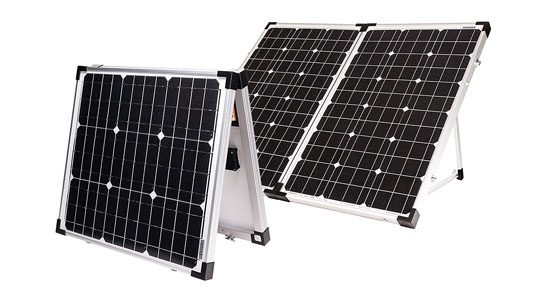
Highlights:
- Quick and easy to set up
- Lightweight & portable
- Heavy-duty case included
- Versatile Anderson-style charging connectors
- 25-year warranty
For some solar panel users, portability is the most important feature. This is especially true for RV enthusiasts. If you’re one of those, Go Power Solar Kit may be a perfect choice for you.
One of the best things about this kit is its overall simplicity. A sturdy padded case is included in the package, allowing one to transport the kit from one place to another easily. Once you’re ready to use the panels, you’ll be able to set them up in a matter of minutes.
To set the Go Power Solar Kit up, one needs to unfold the model and extend its support legs. When used on flat terrain, the unit will sit at a 45-degree angle. All that’s left to do is to connect the battery.
Go Power Solar Kit comes together with a charge controller. It’s situated underneath the panel and shows the battery’s percentage. Always make sure that the controller is set to the adequate setting for the battery you’ll be using. If you’re unsure about its type, take a closer look at it for the specifics.
Besides overall simplicity, this kit is also extremely portable. It is lightweight and small in size, so it won’t take up a lot of space. Its Anderson-style battery charging connectors allow the user to swap between charging accessories quickly. The 25-year warranty sweetens the deal – you won’t have to worry about durability at all.
6. Goal Zero Nomad 7 – Top Pick for Lightweight
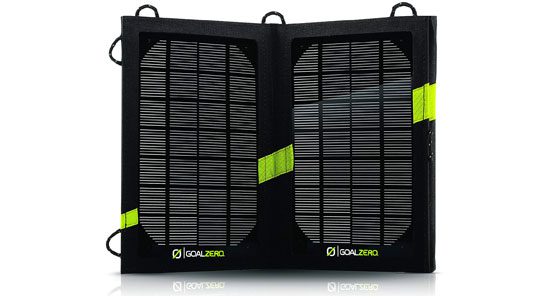
Highlights:
- Great backpacking gear
- Relatively affordable
- Lightweight (1lbs)
- Foldable, rugged design
- Charges most USB devices
The next portable solar panel in our roundup is Goal Zero Nomad 7. At only one pound, it’s one of the most lightweight models we’ve analyzed. However, its low weight is not the only good thing about – check out the rest of its features:
Although small in size, it’s evident that Goal Zero Nomad 7 was made to last. Besides the durable canvas that covers its panels, the model also has large, sturdy pockets. Combining black with bright green, it’s one of the most eye-catching portable solar panels on our list.
Although it doesn’t offer enough wattage for charging more than one device, it provides a myriad of different chords. These will allow you to charge almost any electronic gadget. There’s even a car plug, allowing you to charge your smartphone or camera in case the panel isn’t working when you’re traveling.
One thing we particularly liked is the model’s closure method. Unlike many other portable solar panels, this one doesn’t use Velcro – instead, it closes with magnets. Some may say that this adds unnecessary weight, but Goal Zero Nomad 7 is still one of the most lightweight offerings on the market.
Compact and lightweight, this solar panel is a perfect choice for those on the go. In good sunlight, it is capable of charging an iPhone almost as fast as the wall charger. This makes it ideal for bike tours and hiking adventures.
7. Aeiusny Solar Charger – Top Pick for Speed
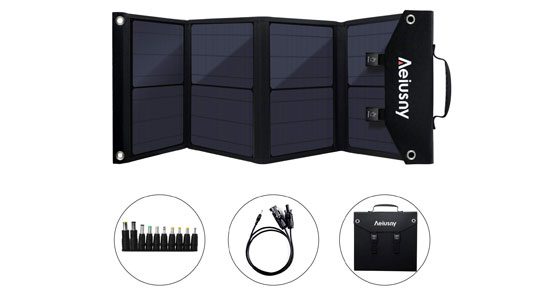
Highlights:
- High conversion efficiency
- Foldable & easy to carry
- Waterproof & resistant to corrosion and high temperatures
- Compatible with most modern gadgets
- Integrated short circuit and surge protection
The last model in our lineup, and also one of the fastest, is the Aeiusny Solar Charger. Foldable, easy to carry, waterproof, and very efficient, it offers fantastic value for the money.
As a portable solar charger, this model is both compact and foldable. These features allow for easy transport and storage. Moreover, they turn Aeiusny Solar Charger into an ideal option for camping, hiking, and cycling.
Another great thing about this unit is that it’s widely compatible. The model’s USB ports are universal, allowing the user to charge almost any device. These include smartphones, headphones, Bluetooth speakers, tablets, and more.
The manufacturer states that the Aeiusny Solar Charger has a 60% better performance than the standard crystalline silicon solar panels.
This isn’t so far from the truth – it is capable of converting 25% of solar power into usable electricity. Moreover, it has an integrated smart IC chip, whose job is to prevent your gadgets from getting damaged during the charging.
Another thing we liked is how durable this charger is. Not only is it waterproof (except for the junction box), but it’s also resistant to corrosion and high temperatures. Besides the unit itself, the package also includes a generator cable, an MC4 to DC5.5*2.1 adapter, three laptop DC adapters, and the user manual.
Durable and fast, Aeiusny Solar Charger looks like a pretty good deal. If you often spend time outdoors, it will allow you to charge your electronic devices on the go – and fast.
Finding the Best Portable Solar Panels – Buying Guide
Choosing a portable solar panel that will suit your needs certainly isn’t rocket science. However, it’s easier to end up with the best possible device when you know what to look for. Have a look at some important factors that you should keep in mind while shopping:
Things to Consider When Choosing the Best Product
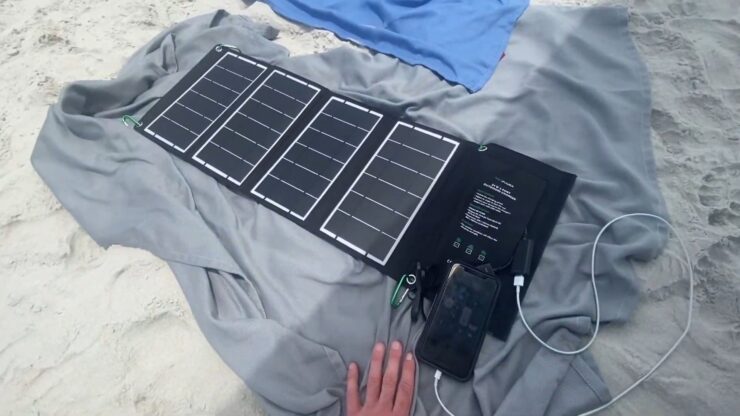
1. Usage
When shopping for portable solar panels, one of the first things you need to consider is their future usage. As you’re looking for a portable model, you will obviously want something with low weight. However, that’s not the only thing to keep in mind.
As a portable device, your solar panel/charger will also need to be resistant to the elements. If you’re a hiking or biking enthusiast, there’s a good chance your model will come into contact with water or dust. Choosing a waterproof model, but also one that’s resistant to corrosion and dirt should be among your top priorities.
Finally, make sure to select a unit with some kind of a hanging/attachment contraption. These include things like carabiners or hooks. As you can already guess, they allow users to hang the panel on their backpacks, letting them charge their gadgets on the go.
2. Versatility
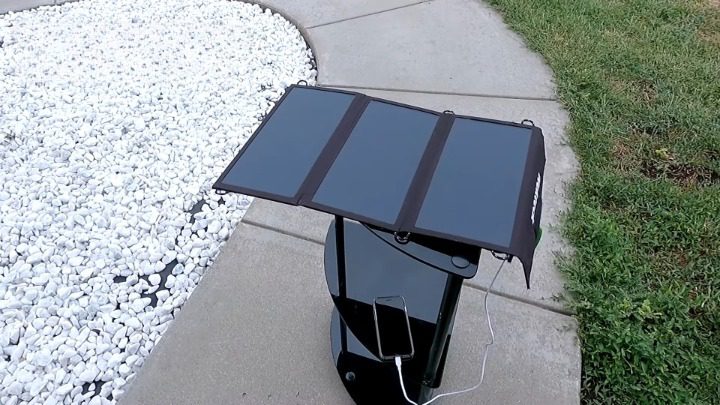
You will also want your solar panel to be versatile. When speaking about versatility, we’re mainly thinking of wide compatibility. As you’ll be dependent on your solar charger during your outdoor adventures, you’ll want to select one that’s compatible with most of your gadgets. You don’t want to buy a model that’s limited only to your phone.
Another thing that can make a particular model versatile is the presence of an ammeter. Portable solar panels with built-in ammeters are, actually, widely available. An ammeter will help you find the best position for peak functionality. It will show you the ampere output once you start charging your gadget.
However, it’s important to mention that some of the best portable solar panels are already versatile in nature. Unlike their roof-mounted counterparts, they can be taken anywhere and used for a myriad of purposes. Most can be folded or come with special cases, making the transport effortless.
3. Technology
When it comes to off-grid and grid-tied markets, crystalline technologies remain the most popular. These hold the most substantial chunk of the market.
They are separated into monocrystalline and polycrystalline modules. However, once we take into account the already-mentioned importance of efficiency values, it’s easy to see that monocrystalline technology is the best for portable solar applications.
Another solar panel technology that needs to be considered is the thin film. It seems like the perfect solution for portable systems, as it is both compact and very flexible. However, thin-film technologies come with a significant downside. Although maneuverable, thin-film panels have much lower efficiency values than their monocrystalline counterparts.
If you have the money, try to obtain a monocrystalline model. The cells used in these panels are cut from a single silicon ingot. This, among other things, allows them to run in the range of ~20% efficiency. Polycrystalline models, on the other hand, rarely go above 16% efficiency.
4. Efficiency
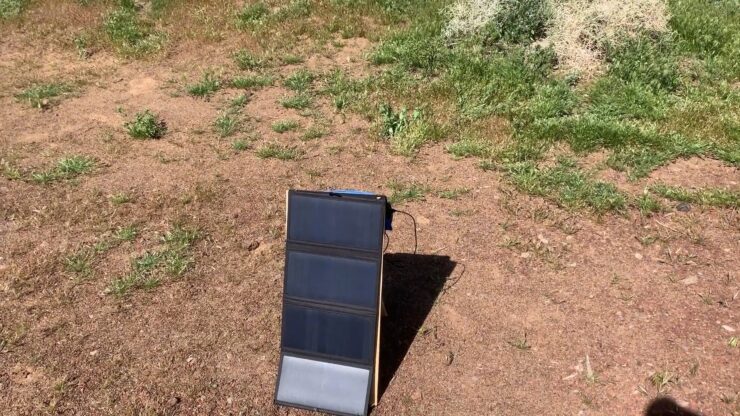
Another crucial thing to look for is efficiency. When it comes to solar panels, efficiency values show how good a particular model is at converting sunlight into usable electricity. Once the sun’s power becomes this usable electricity, it is sent to the model’s circuit box. A person then uses this electricity to charge his/her gadgets.
Typically, efficiency is expressed as a percentage. Imagine two solar panels – they look exactly the same and are of the same size. However, the first one has an efficiency percentage that’s higher than that of its counterpart. This means that the first model can produce more electricity – it’s as simple as that.
Generally speaking, most modern models are far more efficient than their old predecessors. Selecting a solar panel with a higher efficiency value means that you’ll be able to get more electricity out of it for the same size.
Important Features to Look for
1. Size (Wattage)
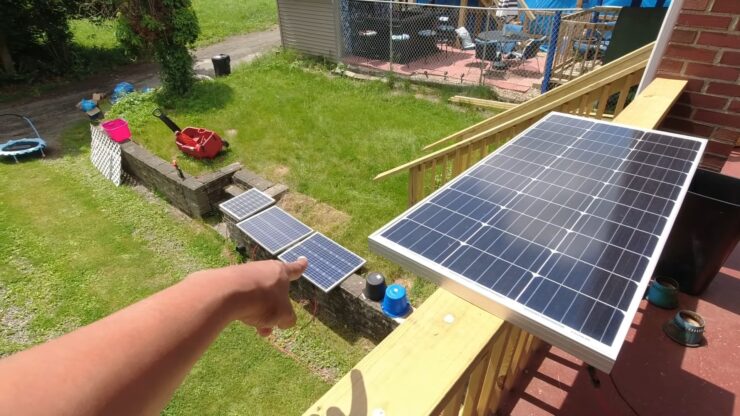
When shopping for a solar panel, you will want to know the power size of your future model. When it comes to these devices, their power output is typically shown as wattage. This term combines two different variables – current and voltage.
As you can see in our roundup, most of the best solar panels and chargers we’ve analyzed have a wattage of around 20-30 Watts. For a portable unit, this is more than enough – you’ll be able to charge all of your electronic gadgets on the go. Things are a bit different from large, stationary models – their power output is greater, which is why they have a higher wattage.
2. Integrated Batteries
Some models of solar panels come with integrated batteries. As you can already guess, these allow one to store electricity converted from sunlight for later use. To put it simply, a unit with an integrated battery extends the use of generated power.
Integrated batteries are not that common with portable solar panels, though. With these devices being used primarily on the go, there’s no real need for them to hold a charge. If you really want to save some solar power for later, you can simply use your solar panel to charge a standard power bank.
3. Weight and Portability
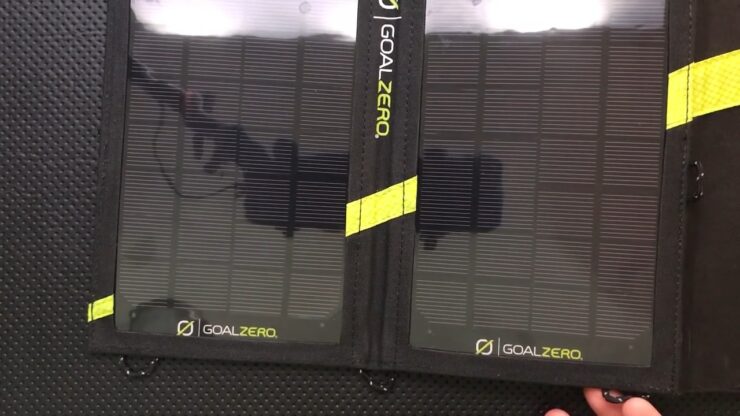
Contrary to popular belief, solar panels actually have a meager weight. This is particularly true for portable models. Goal Zero Nomad 7, for example, weighs only one pound. This makes it super compact and easy to carry around, which is very important for everyone who uses these devices while traveling.
When you’re hiking, your backpack is probably already packed with all sorts of items. You don’t want your solar charger to add any significant extra weight. Models that can be folded are especially convenient – once folded, they take even less space and are easier to store.
4. Ease of Use
Fortunately for all those who don’t like messing with complicated gadgets, portable solar chargers are extremely easy to use. Most models don’t sport any bells and whistles – just the basic functionality of charging your smartphone, tablet, camera, and other devices.
The only thing you really need to care about is the placement of the gadgets you’ll be charging. Many electronic devices won’t charge if they overheat. A good way to prevent this from happening is in using long charging cables. By using one of those, you’ll be able to place your gadget away in a shady spot.
How to Set Up Your Portable Solar Panel?
With your portable solar panel, you’ll be able to charge multiple devices. However, it’s important to understand how to set up your device in the correct way.
Let’s say you’re on a camping trip. You have your portable solar panel, a set of wires, a charge controller, a battery pack, and an inverter. Once you’ve determined the power size, you’ll need to establish the connection in a parallel or a series – this depends on the voltage and current requirements of your charge controller. While the parallel connection adds current, the series connection adds voltages.
Once you’ve connected the terminal outputs, you’ll also have to connect the charge controller input to each terminal output. Connect your terminal outputs to the energy storage device. While doing this, you’ll need to make sure that the controller’s voltage output is the same as the battery pack’s nominal output. Once you’re done with establishing the battery connection, you’ll be able to wire the power AC loads to the battery-based inverter.
Things are much less complicated with the best portable solar panels that are designed to charge phones and similar devices specifically. They look appealing and are very easy to use, letting one charge his smartphone via USB ports.
Designs vary from best solar panels that look like tablets to those that fold down like an accordion. Some models allow charging multiple gadgets at once, such as your Bluetooth speaker, external battery, Go Pro camera, and others.
FAQ
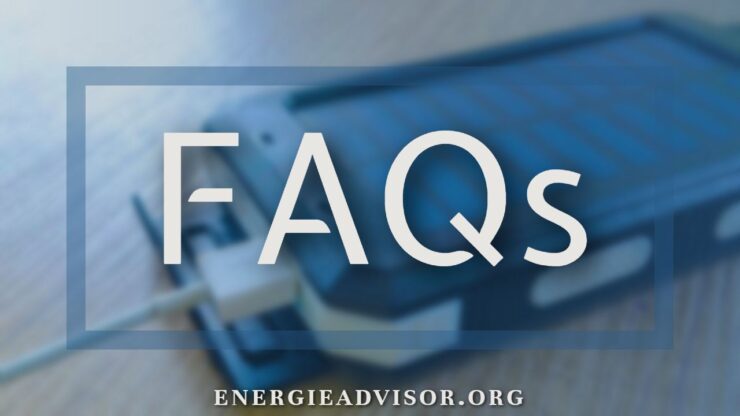
Q1: Are Portable Solar Panels Worth It?
This is a reasonable question as many people are still unsure about the usefulness of portable solar panels. Even though their popularity is on the rise, plenty of individuals are still questioning the need to invest in a solar panel that doesn’t offer much in the way of efficiency due to its smaller surface area.
However, the assumption that a massive area is necessary to produce an ample amount of power is problematic. Portable solar panels have grown in their efficacy since their first appearance on the market. They now come in a wide variety of sizes that can accommodate the needs of most.
Q2: How Do You Secure a Portable Solar Panel?
This depends on the panel itself as different panels require different methods of setting up. That said, the vast majority of portable solar panels only need a swift and straightforward mounting process, which is just as well, since that is one of their main selling points.
As always, carefully reading the instruction manual is a surefire way of setting up your panel correctly. If you want our advice, this is probably a good idea when it comes to other products as well. If the instruction manual is not available for any reason, the manufacturer’s website should provide all the necessary information on how to set everything up correctly.
Q3: How to Use Portable Solar Panels?
Even though portable solar panels may seem complicated at first, you’ll be surprised at how simple they are to figure out once you get to it. Again, the instruction manual is your friend here; follow it carefully and you should be all set.
Once you have the device set up, you should be able to connect the cords to your home, camper, RV, or boat, and that’s all there is to it. The device will begin to convert sunlight into energy as soon as you have everything ready. It’s all surprisingly simple. Just don’t forget to leave the panel out in a sunny area.
Conclusion
Choosing the right portable solar panel for your needs can be a daunting task. To make things easier, try to figure out what will its purpose be and go from there. Do you always need a fully charged phone on your hiking trips? Or are you running a mobile office and always need to have a few different devices charged?
As you increase the wattage, the price will go up, but so will the efficiency. It all depends on your needs and your budget. As you can see in our lineup, each of the portable panels and chargers we’ve reviewed excels at something. This should help you choose the one that suits your requirements.

